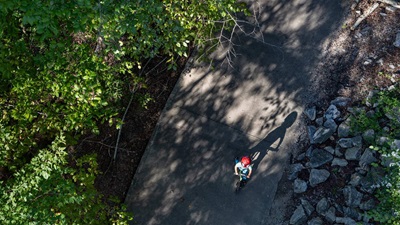Nature-Based Approaches to Disaster Resilience Can Yield Big Returns in States
At Pew-led forum, leaders share lessons on partnerships, financing, and economic benefits to advance critical projects

Across the country, state governments are faced with the increasing frequency and intensity of disasters and the compounding scarcity of resources to plan for and lessen their impacts. With these unprecedented challenges likely to grow, state leaders are turning to one another to share best practices and lessons learned to increase resilience.
One nonpartisan national forum is the State Resilience Planning Group (SRPG) convened by The Pew Charitable Trusts. On Aug. 26-27, the SRPG—including leaders from 20 states, academics, nonprofit experts, and private sector partners—gathered in Athens, Georgia, for its annual in-person meeting. The focus of the meeting, hosted by the University of Georgia Institute for Resilient Infrastructure Systems, was to discuss how to leverage nature and innovative infrastructure solutions.
Presenters emphasized that resilience projects tend to succeed when their economic case is clear. By quantifying the benefits of these projects—such as higher property values, improved public health, or reduced flood damage—state leaders can show legislators, communities, and private partners that resilience is a smart long-term investment.
Monetize, quantify, and communicate resilience benefits
To secure scarce funding, resilience offices and their agency partners are broadening how they measure and communicate project benefits. This is especially important with solutions that funders may be unfamiliar with, such as creating or bolstering living shorelines, restoring and expanding flood plains, and engaging in other resilience tactics that rely on nature.
“Once nature is at the table, it has to be fairly evaluated,” said Heather Tallis, a senior fellow with the Center for Coastal Climate Resilience at the University of California, Santa Cruz. “If you can’t quantify what nature is providing, it too often gets valued at zero.”
Glen Delaney of Earth Economics, a research nonprofit, described how his team reassessed the value of restoring the Duckabush Estuary in Washington state. A traditional benefit-cost analysis estimated that the project yielded just $15 million in avoided flood damage while costing $120 million to complete. But when analysts factored in improvements to salmon habitat, water quality, recreation opportunities, and carbon storage, the project’s benefits rose to $75 million, making the investment far more attractive.
Similar lessons emerged from a green infrastructure plan for Atlanta University Center, where a study showed millions of dollars in long-term economic and recreational returns from implementing a suite of green infrastructure solutions, including expansion of the tree canopy.
Tallis advised states to make changes in policies and guidance to encourage investment in nature for its ability to reduce risks. For instance, a state can define nature and nature-based solutions that feature or mimic ecological processes to address risk—such as restored wetlands or living shorelines—as “infrastructure.” This helps to put them on equal footing with conventional infrastructure, including seawalls and levees. One example she cited was a resolution passed in 2020 by the Puerto Rico legislature declaring coral reefs to be “essential structures” for the protection of the island’s coasts. This allowed Puerto Rico to apply for Federal Emergency Management Agency funding to restore reefs that reduce flood and erosion risk.
The value of innovative financing
States are also testing new ways to fund resilience initiatives.
“The challenges are complex [and] budgets are strained, but investors are motivated,” said Shaun O’Rourke of Quantified Ventures, a climate and conservation finance consulting firm. Citing two recent successes, O’Rourke shared that environmental impact bonds—which link repayment to performance—helped Washington, D.C., and Atlanta to finance water infrastructure improvements.
Green banks—mission-driven financial institutions that operate at the state and local levels—leverage traditional financing strategies to achieve resilience goals, said Sara Mason of the Nicholas Institute for Energy, Environment, and Sustainability at Duke University. Green banks bring together a diverse mix of private and public funds for green infrastructure or energy projects, reducing risk for private investors. They also match investors with proposed projects and facilitate project planning and construction.
Laura Mondragon, director for climate resilience and adaptation with the Montgomery County Green Bank in Maryland, shared how the bank created a dedicated fund to pair sustainability upgrades with measures that address the disproportionate disaster risk faced by those living in affordable housing. Mondragon said this funding has led to innovative, multibenefit housing projects, greater awareness of disaster risk among developers and residents, and better partnerships among financial institutions, communities, and developers.
Seeing green infrastructure in action
To see nature-based resilience projects first hand, event attendees toured green infrastructure sites in Athens, including the North Oconee River Greenway. The tour, guided by Athens-Clarke County Sustainability Director Mike Wharton, highlighted how flood plain restoration and greenway investments deliver multiple returns: reducing flood risks for nearby properties, improving water quality, restoring wildlife habitat, and creating a biking and walking path for residents.
By quantifying benefits, leveraging innovative financing, and integrating projects with multiple purposes, state officials are helping to turn resilience from an abstract goal into outcomes that attract investment even in a changing funding landscape. Building on these successes will require collaboration across sectors, continued experimentation with new tools, and a commitment to scale proven solutions.
The challenge is significant, but so is the opportunity: Resilience projects that safeguard communities today can also drive economic vitality and environmental—and community—health for decades to come.
Kristiane Huber works on climate resilience initiatives for The Pew Charitable Trusts’ U.S. conservation project.










